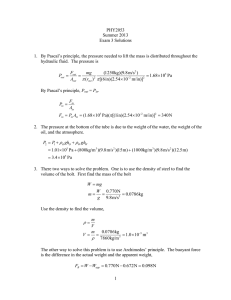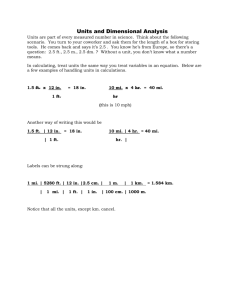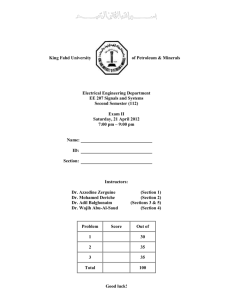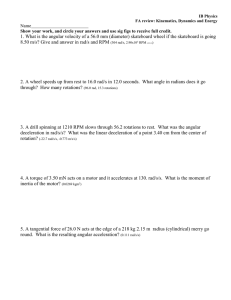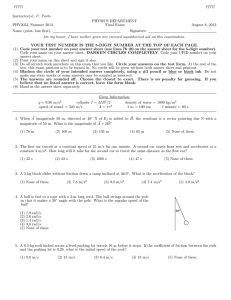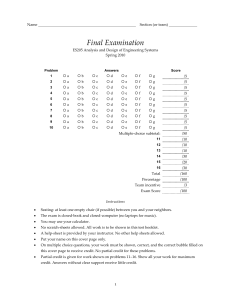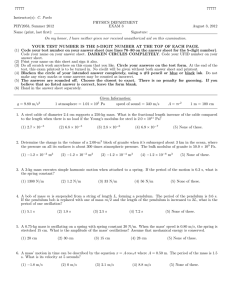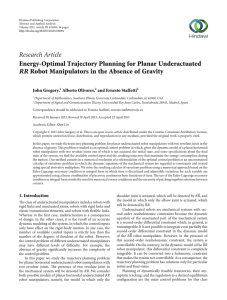77777 C. Parks PHYSICS DEPARTMENT PHY2053, Summer 2013
advertisement
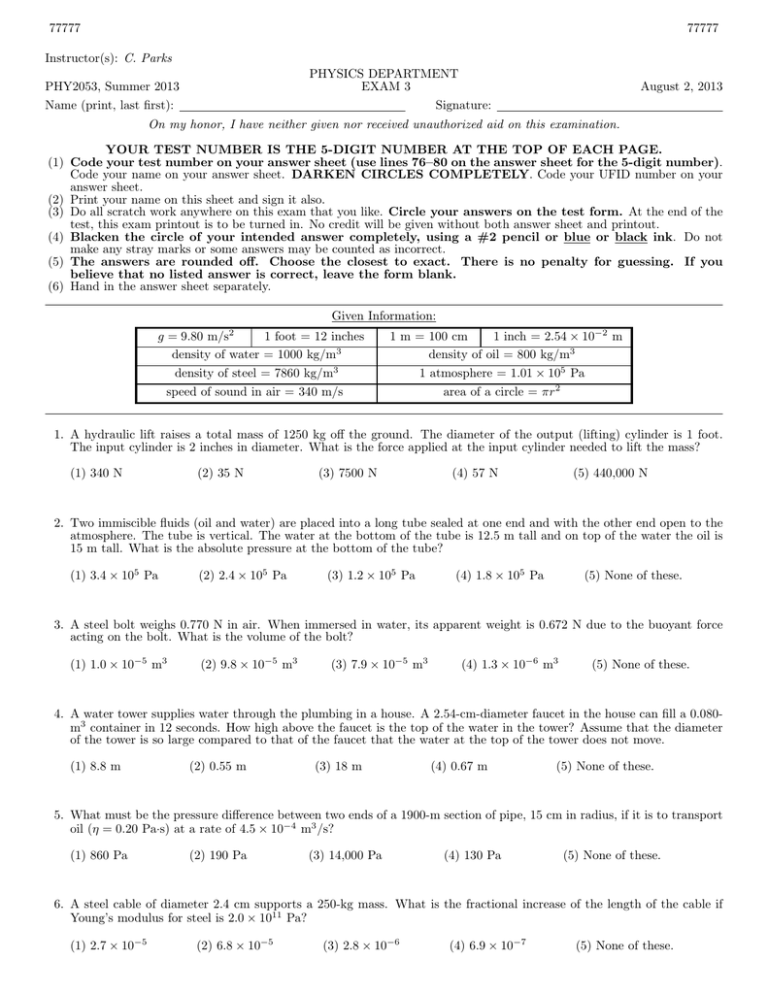
77777 77777 Instructor(s): C. Parks PHYSICS DEPARTMENT EXAM 3 PHY2053, Summer 2013 Name (print, last first): August 2, 2013 Signature: On my honor, I have neither given nor received unauthorized aid on this examination. YOUR TEST NUMBER IS THE 5-DIGIT NUMBER AT THE TOP OF EACH PAGE. (1) Code your test number on your answer sheet (use lines 76–80 on the answer sheet for the 5-digit number). Code your name on your answer sheet. DARKEN CIRCLES COMPLETELY. Code your UFID number on your answer sheet. (2) Print your name on this sheet and sign it also. (3) Do all scratch work anywhere on this exam that you like. Circle your answers on the test form. At the end of the test, this exam printout is to be turned in. No credit will be given without both answer sheet and printout. (4) Blacken the circle of your intended answer completely, using a #2 pencil or blue or black ink. Do not make any stray marks or some answers may be counted as incorrect. (5) The answers are rounded off. Choose the closest to exact. There is no penalty for guessing. If you believe that no listed answer is correct, leave the form blank. (6) Hand in the answer sheet separately. Given Information: 2 g = 9.80 m/s 1 foot = 12 inches density of water = 1000 kg/m3 density of steel = 7860 kg/m3 speed of sound in air = 340 m/s 1 m = 100 cm 1 inch = 2.54 × 10−2 m density of oil = 800 kg/m3 1 atmosphere = 1.01 × 105 Pa area of a circle = πr2 1. A hydraulic lift raises a total mass of 1250 kg off the ground. The diameter of the output (lifting) cylinder is 1 foot. The input cylinder is 2 inches in diameter. What is the force applied at the input cylinder needed to lift the mass? (1) 340 N (2) 35 N (3) 7500 N (4) 57 N (5) 440,000 N 2. Two immiscible fluids (oil and water) are placed into a long tube sealed at one end and with the other end open to the atmosphere. The tube is vertical. The water at the bottom of the tube is 12.5 m tall and on top of the water the oil is 15 m tall. What is the absolute pressure at the bottom of the tube? (1) 3.4 × 105 Pa (2) 2.4 × 105 Pa (3) 1.2 × 105 Pa (4) 1.8 × 105 Pa (5) None of these. 3. A steel bolt weighs 0.770 N in air. When immersed in water, its apparent weight is 0.672 N due to the buoyant force acting on the bolt. What is the volume of the bolt? (1) 1.0 × 10−5 m3 (2) 9.8 × 10−5 m3 (3) 7.9 × 10−5 m3 (4) 1.3 × 10−6 m3 (5) None of these. 4. A water tower supplies water through the plumbing in a house. A 2.54-cm-diameter faucet in the house can fill a 0.080m3 container in 12 seconds. How high above the faucet is the top of the water in the tower? Assume that the diameter of the tower is so large compared to that of the faucet that the water at the top of the tower does not move. (1) 8.8 m (2) 0.55 m (3) 18 m (4) 0.67 m (5) None of these. 5. What must be the pressure difference between two ends of a 1900-m section of pipe, 15 cm in radius, if it is to transport oil (η = 0.20 Pa·s) at a rate of 4.5 × 10−4 m3 /s? (1) 860 Pa (2) 190 Pa (3) 14,000 Pa (4) 130 Pa (5) None of these. 6. A steel cable of diameter 2.4 cm supports a 250-kg mass. What is the fractional increase of the length of the cable if Young’s modulus for steel is 2.0 × 1011 Pa? (1) 2.7 × 10−5 (2) 6.8 × 10−5 (3) 2.8 × 10−6 (4) 6.9 × 10−7 (5) None of these. 77777 77777 7. How much pressure is needed to compress the volume of an iron block by 0.10 percent? The bulk modulus for iron is 90 × 109 Pa. (1) 9.0 × 107 Pa (2) 9.0 × 1013 Pa (3) 9.0 × 1011 Pa (4) 9.0 × 109 Pa (5) None of these. 8. A 3-kg mass stretches a spring by 25 cm. After the mass is pulled down and released, simple harmonic motion ensues. What is the period of the vibrations of the mass? (1) 1.0 s (2) 39 s (3) 6.3 s (4) 0.20 s (5) None of these. 9. A simple pendulum has a period of 2 seconds on the earth. What is its period on Mars? On Mars the acceleration due to gravity is 3.8 m/s2 . (1) 3.2 s (2) 5.2 s (3) 0.78 s (4) 1.2 s (5) None of these. 10. A 2-kg mass is hanging from a spring (k = 50 N/m). The mass is pulled down a distance of 0.25 m from its equilibrium position and then released. What is the mass’ kinetic energy when it is 0.10 m from equilibrium? (1) 1.3 J (2) 1.6 J (3) 1.1 J (4) 1.2 J (5) None of these. 11. The velocity of a mass can be described by v = vm cos ωt, where vm = 4 m/s and ω = 6 rad/s. What is the mass’ position at t = 3 s? (1) −0.50 m (2) 0.51 m (3) 2.6 m (4) 2.5 m (5) None of these. 12. At a distance of 2 m from a ringing bell, the intensity of sound is 0.1 W/m2 . At what distance from the bell is the intensity 0.01 W/m2 ? (1) 6.3 m (2) 20 m (3) 0.63 m (4) 10 m (5) None of these. 13. When the tension in a cord is 75 N, the wave speed is 140 m/s. If the cord is 5 m long, what is its mass? (1) 0.019 kg (2) 0.10 kg (3) 52 kg (4) 0.053 kg (5) None of these. 14. A wave traveling in the −x direction has velocity 60 m/s and wavenumber 3.0 rad/m. What is an equation of the wave? (1) (2) (3) (4) (5) y = A cos((180 rad/s)t + (3.0 rad/m)x) y = A cos((180 rad/s)t − (3.0 rad/m)x) y = A cos((60 m/s)t + (3.0 rad/m)x) y = A cos((60 m/s)t − (3.0 rad/m)x) None of these. 15. Two successive pulses are traveling down a rope as shown. The rope is looped around a rod at its end making it a free point. The amplitude of the left pulse is 3 cm and the amplitude of the right pulse is 4 cm. After the right pulse reaches the end of the rope, it reflects back and the two pulses overlap. What is the amplitude of the overlapping pulses? (1) 7 cm (2) 1 cm (3) 5 cm (4) 4 cm (5) None of these. 77777 77777 16. Tension is maintained in a string by attaching one end to a wall and by hanging a 2.10-kg object from the other end of the string after it passes over a pulley that is 2.00 m from the wall. The string has mass per unit length of 3.55 × 10−5 kg/m. What is the fundamental frequency of standing waves in the string? (1) 190 Hz (2) 95 Hz (3) 61 Hz (4) 120 Hz (5) None of these. 17. What is the intensity of a 70 dB sound wave. The threshold of hearing is 1.0 × 10−12 W/m2 . (1) 1.0 × 10−5 W/m2 (2) 7.0 W/m2 (3) 1.8 W/m2 (4) 1.0 W/m2 (5) None of these. 18. What are the two lowest frequencies for a 1-m long pipe open at both ends? (1) 170 Hz, 340 Hz (2) 170 Hz, 510 Hz (3) 85 Hz, 255 Hz (4) 85 Hz, 170 Hz (5) None of these. 19. When two sound waves are close in frequency, the superposition of the two produces a pulsation we call (1) beats (2) pulse envelopes (3) overtones (4) harmonics (5) None of these. 20. An ambulance traveling at 35 m/s approaches a car heading in the opposite direction at 25 m/s. At rest, the siren sounds at 550 Hz. What frequency is heard by the driver of the other car? (1) 660 Hz (2) 570 Hz (3) 460 Hz (4) 550 Hz (5) None of these.
